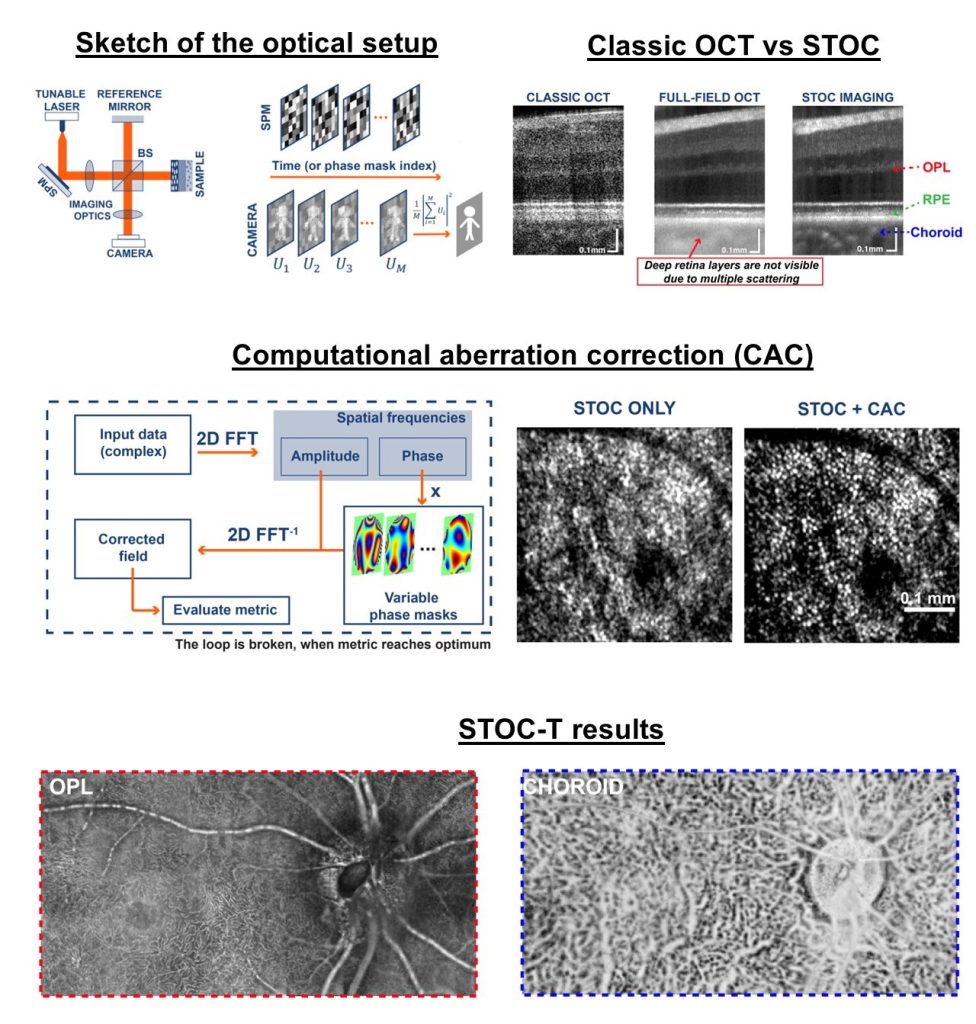Conventional scanning OCT combines time- with confocal gating enabling high-speed, high-resolution cross-sectional imaging of the human retina. Classic OCT, however, does not provide high-resolution en face images of the outer retinal layers due to eye aberrations and the fundamental tradeoff between imaging depth and transverse resolution.
This tradeoff is reduced by a full-field OCT (FF-OCT) method that uses a two-dimensional camera instead of a single-element photodiode. However, an attempt to boost the FF-OCT imaging speed by Fourier-domain (FD) detection resulted in another severe limitation – spatial coherence of the laser generates coherent artifacts, which reduces the spatial resolution and, as shown below, precludes visualization of deep retina layers.

To solve this problem, we developed a new way of controlling the optical phase called STOC (Spatio-Temporal Optical Coherence). Application of STOC to Fourier-domain full-field optical coherence tomography (FD-FF-OCT) is called STOC tomography (STOC-T) or STOC imaging and enabled obtaining in vivo high-resolution, volumetric images of human skin, retina, and cornea at unprecedented speeds.
In STOC imaging, we have extended FD-FF-OCT with a spatial phase modulator (SPM). The SPM dynamically modulates the phase of incident light by generating time-varying transverse mode (TEM) patterns. This is accomplished through the use of active modulators or long multimode optical fiber. The resulting signals are processed and averaged to produce noise-free volume images of the sample. Phase modulation acts here as an additional optical gating mechanism that isolates the signal used to create images. The result is improved images of the sample.
However, the en face images (XY projections) are distorted by eye or sample-induced aberrations. We overcome them in post-processing using the computational aberration correction (CAC). The CAC algorithm proceeds as sketched in the figure. Specifically, we iteratively (in the computer) correct the phase of the spatial spectrum until we optimize the image sharpness metric:
To achieve wide-field retina images, we perform measurements at different locations and then stitch resulting volumes together to render high-resolution, high-fidelity retinal images at different depths (indicated earlier). Specifically, we render the choroid, which was impossible with conventional Fourier-domain FF-OCT (without phase modulation).
Text: Dawid Borycki, PhD
Team:
References:
- M. Wojtkowski, P. Stremplewski, E. Auksorius, and D. Borycki, “Spatio-Temporal Optical Coherence Imaging – a new tool for in vivo microscopy,” Photonics Letters of Poland 11, 45-50 (2019). https://photonics.pl/PLP/index.php/letters/article/view/11-15
- Borycki, D. et al., Control of the optical field coherence by spatiotemporal light modulation, Opt. Lett., 2013 38(22): p. 4817-4820.
- Borycki, D., et al., Spatiotemporal optical coherence (STOC) manipulation suppresses coherent cross-talk in full-field swept-source optical coherence tomography. Biomed Opt Express, 2019. 10(4): p. 2032-2054.
- Stremplewski, P., et al., In vivo volumetric imaging by crosstalk-free full-field OCT. Optica, 2019. 6(5): p. 608-617.
- Auksorius, E., et al., Crosstalk-free volumetric in vivo imaging of a human retina with Fourier-domain full-field optical coherence tomography. Biomed Opt Express, 2019. 10(12): p. 6390-6407.
- Auksorius, E., et al., In vivo imaging of the human cornea with high-speed and high-resolution Fourier-domain full-field optical coherence tomography. Biomed Opt Express, 2020. 11(5): p. 2849-2865.
- Borycki, D., et al., Computational aberration correction in spatiotemporal optical coherence (STOC) imaging. Opt Lett, 2020. 45(6): p. 1293-1296.
- Egidijus Auksorius, Dawid Borycki, Maciej Wojtkowski, Multimode fiber enables control of spatial coherence in Fourier-domain full-field optical coherence tomography for in vivo corneal imaging, Opt Lett, 2021. 46(6): p. 1413-1416.
- Auksorius E., et al., Spatio-Temporal Optical Coherence Tomography provides advanced imaging of the human retina and choroid, arXiv preprint arXiv:2107.10672 (2021).
- Auksorius E., Fourier-domain full-field optical coherence tomography with real-time axial imaging, Opt Lett, 2021., Vol. 46(18): p. 4478-4481.
- Auksorius E., et al., Multimode fiber as a tool to reduce cross talk in Fourier-domain full-field optical coherence tomography. Opt Lett, 2022. 47(4): p. 838-841.
- Tomczewski S., et al., Light-adapted flicker optoretinograms captured with a spatio-temporal optical coherence-tomography (STOC-T) system. Biomed Opt Express, 2022 13(4): p. 2186-2201.
- Auksorius, E., et al., Spatio-temporal optical coherence tomography provides full thickness imaging of the chorioretinal complex. iScience, 2022 25(12) 105513.


